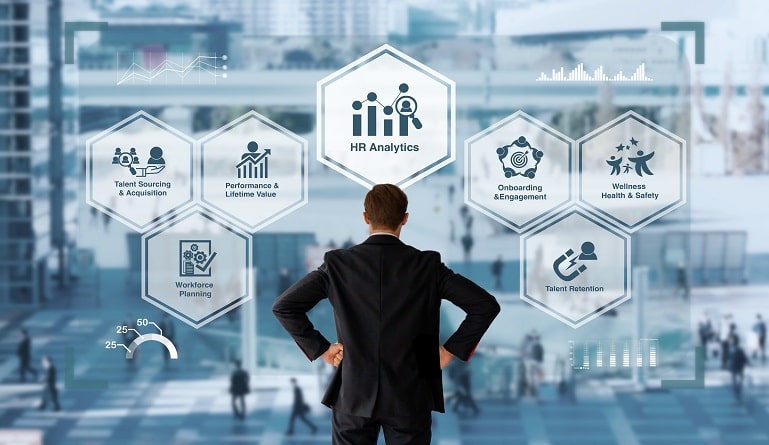New technology brings along improved processes and intel. Where data once sat still with no one being sure how to use it, that is no longer the case. We are seeing new ways of collecting, calculating, processing and reporting data so that companies can use it.
Though the possibilities with these analytics are endless, below are the top ten human resource analytics trends to follow in 2020.
1. Automated Recruiting
By gathering data about who best fits a position or the type of employee that the company is looking for, finding that employee can take much less time. Automation and/or AI will be widely used to weed out candidates that do not fit the description and locate those that do.
2. AI-Enabled New Hire Selection
How often have you hired an employee that left soon after, or that was not a good match for the company? For years, hiring decisions have been made at least partially with an opinion about an interviewee, but opinions are not always correct. AI, on the other hand, can make hiring decisions solely from facts and the data that it is given to use. Without opinion or bias, AI can make much wiser choices.
3. Interactive Training
Some organizations are beginning to use virtual reality to provide interactive training for both current employees and new hires. Gathered data shows a company where extra training may be needed, then the company creates an interactive training program. For instance, imagine that a large retailer gathered feedback from its customers about their experiences in-store. The feedback was great until they were asked about the checkout process. As the feedback is consistent among customers, the retailer might put together a virtual training for the cashiers on how to properly check out the customers.
4. Predictive Reporting
You cannot fix a problem if you do not know what the problem is. Analytics and AI will be used to determine certain factors, such as how long an employee may stay, why they leave, and so on. This data will lead to predictions that management can then use to improve the entire organization.
5. Reduce Employee Turnover
The predictive reporting will also provide data specifically concerning employee turnover. When human resources understand the reasons behind employee turnover, the department can work toward fixing the issues. While it may not eradicate turnover, it will very likely decrease it.
6. Use of Chatbots
If you have ever had the need to call human resources, you likely experienced a wait time like nothing else. Whether it is due to being buried under piles of paperwork or having too many calls to return, callers often wait hours or even weeks for the answers they seek. However, some human resources departments have begun using analytics to put chatbots to work. The chatbots are trained to answer many frequently asked questions pertaining to topics such as benefits. This will likely increase in popularity in 2020.
7. Personalizing the Employee Experience
Employee satisfaction often affects whether employees choose to stay or not as well as how much effort they put into their job. For instance, if a new hire has a bad onboarding and training experience, he or she may already be halfway out the door before they even really start working. By using human resource analytics to personalize and improve the employee experience, you set a good tone for the organization, which will likely decrease turnover and missed workdays.
8. Providing a Human Touch
For many years, human resource departments have had to spend most of their time on everything except for human interaction. Lately, however, HR has had the ability to use analytics to automate processes that do not need a human. Companies will continue to use HR analytics to automate the most repetitive tasks or train AI to do so. This frees human resources up to provide more of the “human” side that they can then use in other important areas, such as creating customer retention processes and programs.
9. Employee Engagement
Employee engagement is a human resource analytics trend in 2019 and will be an even bigger focus in 2020. Gathering feedback and using the insights gained, employers, see areas in which they can create engagement. For instance, a survey might show that employees would enjoy a company picnic or health incentives. The organization can use this information to prepare for a picnic or speak with leadership about what incentives could be offered for weight loss.
10. Performance Measurement
As the younger generation comes in with career advancement on their minds, organizations need to prepare to promote from within. Often, the perfect candidate for a position is right under a management team’s nose, but they have no idea. If management hires someone from outside of the company and ignores the internal candidate, he or she will feel devalued and most likely look for employment elsewhere. Organizations cannot afford to lose employees due to overlooking someone. With human resource analytics and automation, internal employees’ performance can be measured and brought to leadership’s attention.
Though many people assume that technology will take away human positions, it has instead, improved those positions. As with these ten trends, new and improved technology frees up time to humans to implement critical changes. As organizations become more centered on people, it is imperative to follow their lead to stay competitive.
There are many ways in which HR analytics can improve your company. Along with other leaders in your organization, determine the data you want to gather first. Then choose the tools and platforms you will use to gather and analyze that data.




